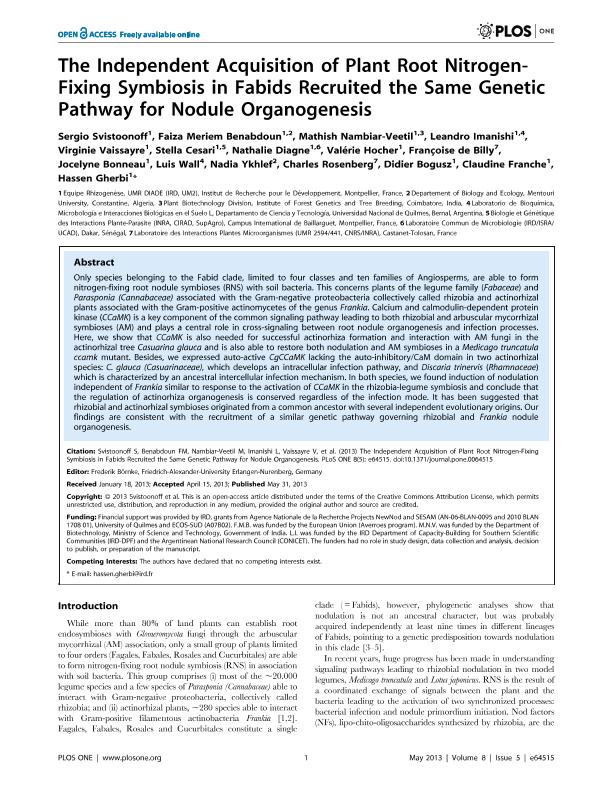Artículo
The independent acquisition of plant root nitrogen-fixing symbiosis in Fabids recruited the same genetic pathway for nodule organogenesis
Svistoonoff, Sergio; Benabdoun, Faiza Meriem; Nambiar Veetil, Mathish; Imanishi, Leandro Ezequiel ; Vaissayre, Virginie; Cesari, Stella; Diagne, Nathalie; Hocher, Valérie; de Billy, Françoise; Wall, Luis Gabriel
; Vaissayre, Virginie; Cesari, Stella; Diagne, Nathalie; Hocher, Valérie; de Billy, Françoise; Wall, Luis Gabriel ; Ykhlef, Nadia; Rossemberg, Charles; Bogusz, Didier; Franche, Claudine; Gherbi, Hassen
; Ykhlef, Nadia; Rossemberg, Charles; Bogusz, Didier; Franche, Claudine; Gherbi, Hassen
 ; Vaissayre, Virginie; Cesari, Stella; Diagne, Nathalie; Hocher, Valérie; de Billy, Françoise; Wall, Luis Gabriel
; Vaissayre, Virginie; Cesari, Stella; Diagne, Nathalie; Hocher, Valérie; de Billy, Françoise; Wall, Luis Gabriel ; Ykhlef, Nadia; Rossemberg, Charles; Bogusz, Didier; Franche, Claudine; Gherbi, Hassen
; Ykhlef, Nadia; Rossemberg, Charles; Bogusz, Didier; Franche, Claudine; Gherbi, Hassen
Fecha de publicación:
05/2013
Editorial:
Public Library of Science
Revista:
Plos One
ISSN:
1932-6203
Idioma:
Inglés
Tipo de recurso:
Artículo publicado
Clasificación temática:
Resumen
Only species belonging to the Fabid clade, limited to four classes and ten families of Angiosperms, are able to form nitrogen-fixing root nodule symbioses (RNS) with soil bacteria. This concerns plants of the legume family (Fabaceae) and Parasponia (Cannabaceae) associated with the Gram-negative proteobacteria collectively called rhizobia and actinorhizal plants associated with the Gram-positive actinomycetes of the genus Frankia. Calcium and calmodulin-dependent protein kinase (CCaMK) is a key component of the common signaling pathway leading to both rhizobial and arbuscular mycorrhizal symbioses (AM) and plays a central role in cross-signaling between root nodule organogenesis and infection processes. Here, we show that CCaMK is also needed for successful actinorhiza formation and interaction with AM fungi in the actinorhizal tree Casuarina glauca and is also able to restore both nodulation and AM symbioses in a Medicago truncately ccamk mutant. Besides, we expressed auto-active CgCCaMK lacking the auto-inhibitory/CaM domain in two actinorhizal species: C. glauca (Casuarinaceae), which develops an intracellular infection pathway, and Discaria trinervis (Rhamnaceae) which is characterized by an ancestral intercellular infection mechanism. In both species, we found induction of nodulation independent of Frankia similar to response to the activation of CCaMK in the rhizobia-legume symbiosis and conclude that the regulation of actinorhiza organogenesis is conserved regardless of the infection mode. It has been suggested that rhizobial and actinorhizal symbioses originated from a common ancestor with several independent evolutionary origins. Our findings are consistent with the recruitment of a similar genetic pathway governing rhizobial and Frankia nodule organogenesis.
Palabras clave:
Frankia
,
Actinorrizas
,
Symbiosis
,
Discaria
Archivos asociados
Licencia
Identificadores
Colecciones
Articulos(SEDE CENTRAL)
Articulos de SEDE CENTRAL
Articulos de SEDE CENTRAL
Citación
Svistoonoff, Sergio; Benabdoun, Faiza Meriem; Nambiar Veetil, Mathish; Imanishi, Leandro Ezequiel; Vaissayre, Virginie; et al.; The independent acquisition of plant root nitrogen-fixing symbiosis in Fabids recruited the same genetic pathway for nodule organogenesis; Public Library of Science; Plos One; 8; 5; 5-2013; 1-10; e64515
Compartir
Altmétricas



